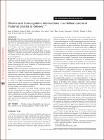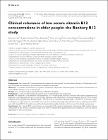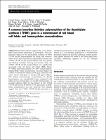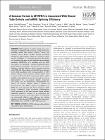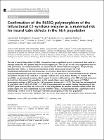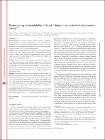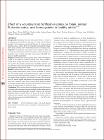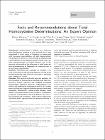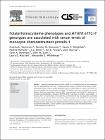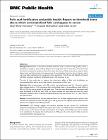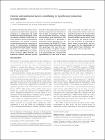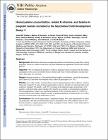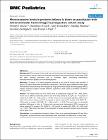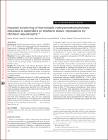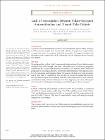Browsing by Author "SCOTT, JOHN MARTIN"
Now showing items 1-20 of 33
-
Choline and homocysteine interrelations in umbilical cord and maternal plasma at delivery.
MOLLOY, ANNE MARIE; SCOTT, JOHN MARTIN (American Society for Clinical Nutrition, 2005)Background: Little is known about the interactions between choline and folate and homocysteine metabolism during pregnancy despite the facts that pregnancy places considerable stress on maternal folate and choline stores ... -
Clinical relevance of low serum vitamin B12 concentrations in older people: the Banbury B12 study.
MOLLOY, ANNE MARIE; SCOTT, JOHN MARTIN (Oxford University Press, 2006)BACKGROUND: low vitamin B12 concentrations are common in older people, but the clinical relevance of biochemical evidence of vitamin B12 deficiency in the absence of anaemia is uncertain. OBJECTIVE: to examine associations ... -
Cobalamin, folic acid, and homocysteine
SCOTT, JOHN MARTIN (John Wiley, 2009)Cobalamin deficiency can lead to several adverse health consequences: folate trapping in the methylation cycle and subsequent impaired DNA biosynthesis; pernicious anemia hematologically, similar to that caused by folate ... -
A common insertion/deletion polymorphism of the thymidylate synthase (TYMS) gene is a determinant of red blood cell folate and homocysteine concentrations
MCPARTLIN, JOSEPH; SCOTT, JOHN MARTIN (Springer, 2005)Substantial evidence suggests that a low folate/high homocysteine phenotype is pathogenic. We analyzed the impact of the thymidylate synthase (TYMS) 3UTR ins/del polymorphism on folate and homocysteine levels and assessed ... -
A common variant in MTHFD1L is associated with neural tube defects and mRNA splicing efficiency
MOLLOY, ANNE MARIE; SCOTT, JOHN MARTIN (2009)Polymorphisms in folate-related genes have emerged as important risk factors in a range of diseases including neural tube defects (NTDs), cancer, and coronary artery disease (CAD). Having previously identified a polymorphism ... -
Confirmation of the R653Q polymorphism of the trifunctional C1-synthase enzyme as a maternal risk for neural tube defects in the Irish population.
MOLLOY, ANNE MARIE; SCOTT, JOHN MARTIN (Nature Publishing Group, 2006)The risk of neural tube defects (NTDs) is known to have a significant genetic component that could act through either the NTD patient and/or maternal genotype. The success of folic acid supplementation in NTD prevention ... -
Detection of vitamin B12 deficiency in older people by measuring vitamin B12 or the active fraction of vitamin B12, holotranscobalamin.
MOLLOY, ANNE MARIE; SCOTT, JOHN MARTIN (American Association for Clinical Chemistry, 2007)Background: Impaired vitamin B12 function and decreased vitamin B12 status have been associated with neurological and cognitive impairment. Current assays analyze total vitamin B12 concentration, only a small percentage ... -
Determining bioavailability of food folates in a controlled intervention study
MOLLOY, ANNE MARIE; SCOTT, JOHN MARTIN (2004)Background: The concept of dietary folate equivalents (DFEs) in the United States recognizes the differences in bioavailability between natural food folates and the synthetic vitamin, folic acid. However, many published ... -
Effect of a voluntary food fortification policy on folate, related B vitamin status, and homocysteine in healthy adults.
MOLLOY, ANNE MARIE; SCOTT, JOHN MARTIN (2007)Background: Mandatory folic acid fortification of food is effective in reducing neural tube defects and may even reduce stroke-related mortality, but it remains controversial because of concerns about potential adverse ... -
Evidence of unmetabolised folic acid in cord blood of newborn and serum of 4-day-old infants
MCPARTLIN, JOSEPH; SCOTT, JOHN MARTIN; WEIR, DONALD (Cambridge University Press, 2007)Oral folic acid above certain threshold doses results in unmetabolised folic acid in serum. This raises a number of public health safety issues, principally the potential to mask pernicious anaemia; more recently the ... -
Facts and recommendations about total homocysteine determinations: an expert opinion
MCPARTLIN, JOSEPH; SCOTT, JOHN MARTIN (American Association for Clinical Chemistry, 2004)Background: Measurement of plasma total homocysteine has become common as new methods have been introduced. A wide range of disorders are associated with increased concentrations of total homocysteine. The purpose of this ... -
Folate/homocysteine phenotypes and MTHFR 677C>T genotypes are associated with serum levels of monocyte chemoattractant protein-1.
SCOTT, JOHN MARTIN (Elsevier, 2009)Monocyte chemoattractant protein-1 (MCP-1) is a chemokine that recruits monocytes into the subendothelial cell layer in atherosclerotic lesions. Elevated homocysteine (hyperhomocysteinemia), which is usually associated ... -
Folic acid fortification and public health: report on threshold doses above which unmetabolised folic acid appear in serum
MOLLOY, ANNE MARIE; SCOTT, JOHN MARTIN; MC PARTLIN, JOSEPH (2007)Background All flour in the USA is fortified with folic acid at a level of 140 ?g/100 g which is estimated to supply an extra 100 ?g daily to the average diet. Some researchers have advocated that this be increased to ... -
Genetic and nutritional factors contributing to hyperhomocysteinemia in young adults
SCOTT, JOHN MARTIN (American Society of Hematology, 2003)A modestly elevated total plasma homocysteine concentration (tHcy) is generally accepted as an independent and graded risk factor for various pathologies, including vascular diseases, neural tube defects, Alzheimer disease, ... -
Genetic and nutritional factors contributing to hyperhomocysteinemia in young adults
MCPARTLIN, JOSEPH; SCOTT, JOHN MARTIN (The American Society of Hematology, 2003)A modestly elevated total plasma homocysteine concentration (tHcy) is generally accepted as an independent and graded risk factor for various pathologies, including vascular diseases, neural tube defects, Alzheimer disease, ... -
Homocysteine concentration, related B vitamins, and betaine in pregnant women recruited to the Seychelles Child Development Study.
MOLLOY, ANNE MARIE; SCOTT, JOHN MARTIN (2008)BACKGROUND: Both folate and betaine are important predictors of total homocysteine (tHcy) during pregnancy. However, studies to date have only been undertaken in populations with Western dietary patterns. OBJECTIVE: We ... -
Homocysteine, folate enzymes and neural tube defects
SCOTT, JOHN MARTIN; MOLLOY, ANNE MARIE (1999)Background: The purpose of this study was to characterize total homocysteine (tHcy) levels at birth in preterm and term infants and identify associations with intraventricular hemorrhage (IVH) and other neonatal outcomes ... -
Impact of the MTHFR C677T polymorphism on risk of neural tube defects:case-control study
MOLLOY, ANNE MARIE; SCOTT, JOHN MARTIN (BMJ, 2004)Homozygosity for the T allele of the C677T polymorphism of the gene encoding the folate dependent enzyme 5,10-methylenetetrahydrofolate reductase (MTHFR) is a risk factor for neural tube defects.1 Both the homozygous (TT) ... -
Impaired functioning of thermolabile methylenetetrahydrofolate reductase is dependent on riboflavin status: implications for riboflavin requirements
MCPARTLIN, JOSEPH; SCOTT, JOHN MARTIN (American Society for Clinical Nutrition, 2002)Background: Methylenetetrahydrofolate reductase (MTHFR; EC 1.7.99.5) supplies the folate needed for the metabolism of homocysteine. A reduction in MTHFR activity, as occurs in the homozygous state for the 677CT (so-called ... -
Lack of Association between Folate-Receptor Autoantibodies and Neural-Tube Defects
MOLLOY, ANNE MARIE; SCOTT, JOHN MARTIN (2009)Molloy AM, Quadros EV, Sequeira JM, Troendle JF, Scott JM, Kirke PN, Mills JL. `Lack of Association between Folate-Receptor Autoantibodies and Neural-Tube Defects? in New England Journal of Medicine, 361, (2), 2009, pp 152-160




